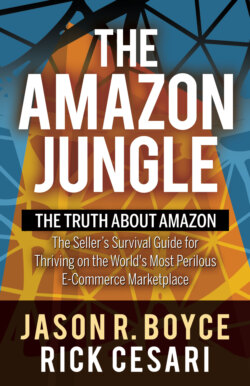Читать книгу The Amazon Jungle - Rick Cesari - Страница 12
На сайте Литреса книга снята с продажи.
Chapter 1: FROM NOWHERE TO EVERYWHERE
Оглавление“AMAZON IS AN UTTER PHENOMENON AND THERE’S HARDLY BEEN ANYTHING LIKE IT IN THE HISTORY OF OUR COUNTRY.”
CHARLES MUNGER, LONGTIME BUSINESS PARTNER OF WARREN BUFFET
My journey on Amazon started in 2003, long before Jeff Bezos realized his vision of the Everything Store we know today. Amazon offered products in multiple categories, like books, electronics, even clothing, but it wasn’t anything like it is now. After the dot-com bubble burst in 2001, Amazon was hurting and relied on a deal it struck with Toys “R” Us in August of 2000 (among other deals) to keep it alive. Under that agreement, Toys “R” Us paid $50 million a year for 10 years, plus a percentage of sales, for an exclusivity provision with exceptions that made them the sole seller of toys on Amazon.
But in 2002 Amazon started allowing other businesses to list their goods on the Amazon.com platform, including toys. I know, because in the holiday season of 2003, I was making daily trips in a U-Haul Truck to a Los Angeles distribution center to fill orders for the Razor Scooters I’d sold on Amazon the night before—thousands upon thousands of them. My brothers and I were selling the same scooter on Amazon that Toys “R” Us was selling, and we were killing it! Not surprisingly, Toys “R” Us was not pleased, and they later filed a lawsuit against Amazon that took them more than a decade to win. In the meantime, Amazon doubled in size and Toys “R” Us went bankrupt.
Not only was Amazon inviting greater competition among Sellers who were selling to Amazon, known as first-party sellers (1P), but Team Bezos had opened the door to Third-Party Sellers (3P), who sold products on Amazon. Saul Hansell, in an article for The New York Times explained Amazon’s virtual surge as motivated by the desire “to replicate the success of eBay,” whose first-of-its-kind digital auction-style format was kicking Amazon’s butt.5
In 2003 we were one of the first to get a phone call from Amazon, back when desk telephones were still wired to the wall, about selling our basketball hoops in their brand new Sports & Outdoors category. At the time, the hoops, for which we were driving online traffic (at a nickel a click) were noticeably outperforming other hoops on search engines like Overture.com (later acquired by Yahoo). In fact, we were selling basketball hoops on Amazon.com before Amazon itself was selling basketball hoops on Amazon!
Of course we weren’t the only ones being recruited to expand Amazon’s stake in the virtual marketplace. Amazon was calling everyone with an online presence. What began as an easy new sales channel for us pioneers quickly became harder as more sellers flocked to sell their wares on the new online marketplace. Back then, my brothers and I were selling other people’s brands, a model that later became unsustainable for us on Amazon because every time a new Seller launched the same product, they’d do so at a lower price to win the sale. In response, we were forced to lower our prices and our profit margins began to shrink—fast. To compound the problem, Amazon itself got into the game, buying our same products from the same brands and selling them for less.
Spalding was a top-selling brand for us at the time. In fact, we sold so many Spalding basketball products online that Spalding gave us all-expense-paid trips to attend NBA All-Star games for four straight years in a row. The best part? We were booked into the same hotels as the NBA legends. I’ll never forget telling Shaq in a hotel elevator how he broke my heart when he left Los Angeles for Miami! But as competition exploded on Amazon, boosted by the Prime Free 2-Day Shipping rollout in 2005, we went from owning the coveted Buy Box for most of Spalding’s top-selling products to losing them all to Amazon, along with that all-expense-paid All-Star experience. Oh well, thanks for the memories.
We knew this would happen eventually, but we were shocked by how quickly Amazon bought and resold every brand imaginable. They had the traffic data, product data, sales data, and knowledge from 3P Sellers like us to literally take over entire categories—overnight. Add to it the tremendous buying power of Amazon; then subtract out the small guys’ ability to compete. The only way to maintain our sales and stay in the Buy Box was to lower prices. This race to the bottom became an inevitable consequence of Amazon’s Marketplace structure, and it was no doubt part of Mr. Bezos’ original vision to have the lowest prices, no matter what. This phenomenon still vexes Sellers today, and it eventually forced my brothers and me to rethink our entire approach to selling online. This process repeated itself four times over the years until we finally landed on the strategy that I will share with you in the coming chapters.
